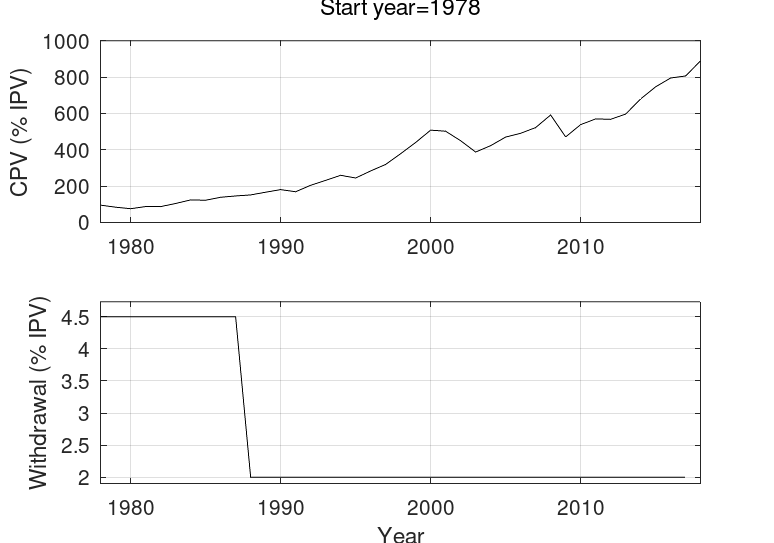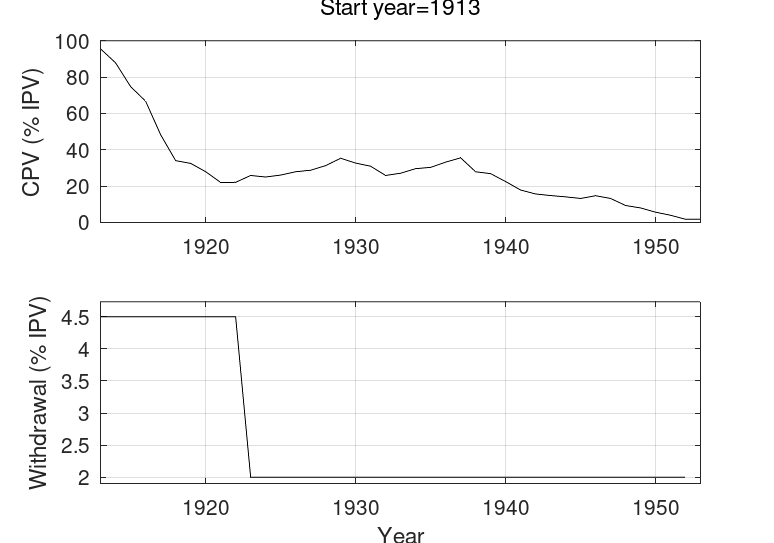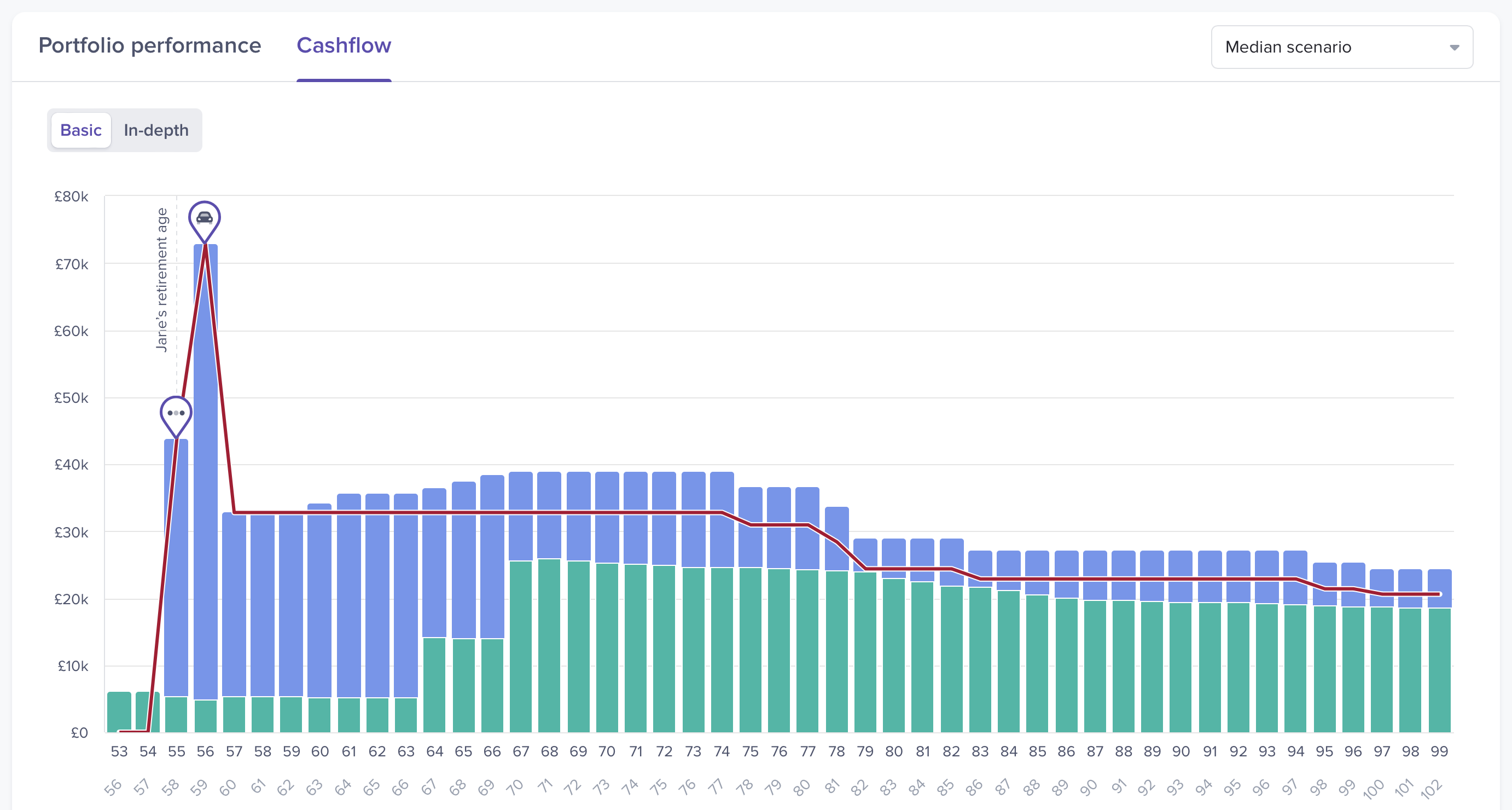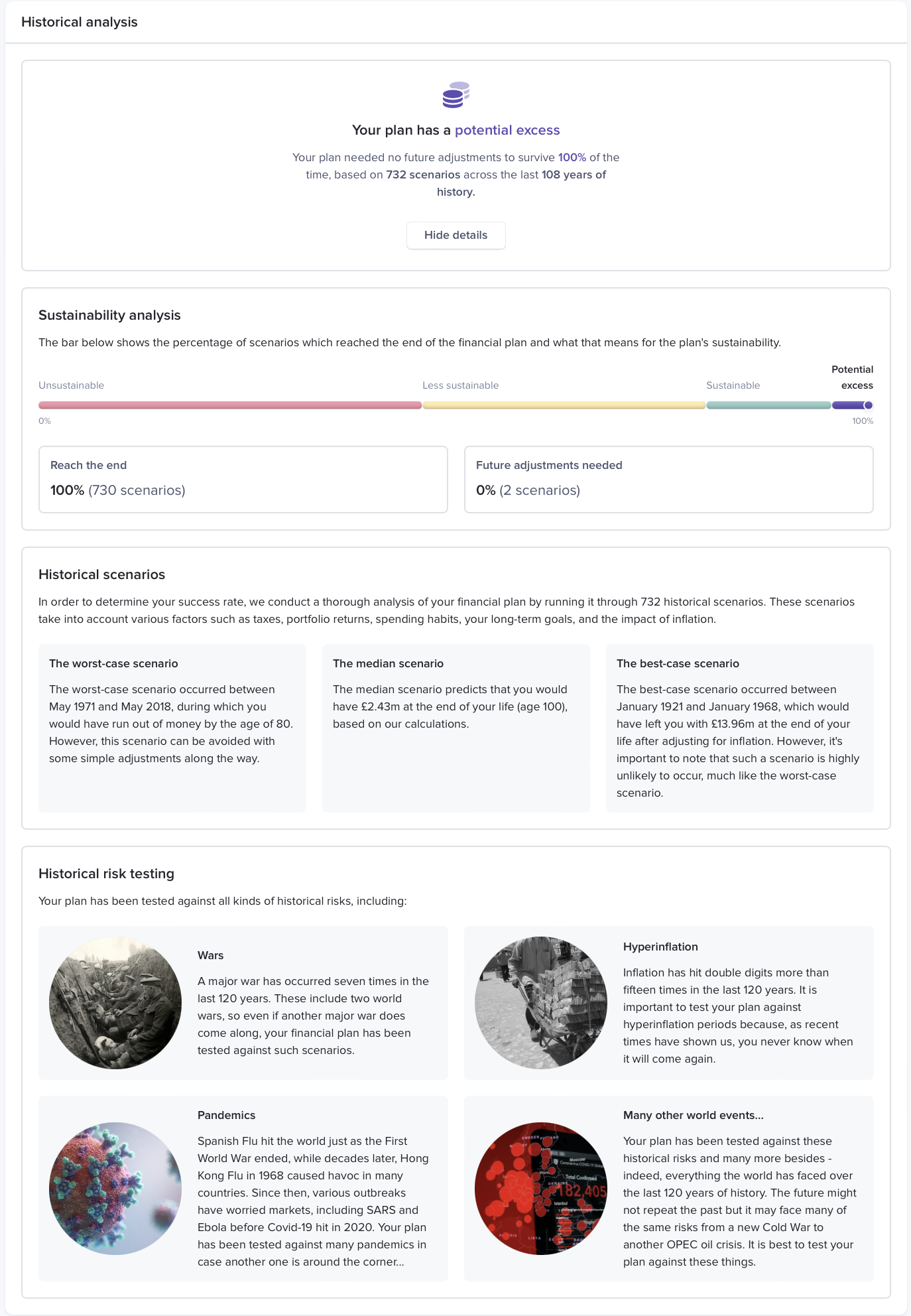We’d like to remind Forumites to please avoid political debate on the Forum.
This is to keep it a safe and useful space for MoneySaving discussions. Threads that are – or become – political in nature may be removed in line with the Forum’s rules. Thank you for your understanding.
Dynamic spending rules for retirement drawdown pros/cons and alternatives?
Comments
-
Yes Timeline will take into account the additional income streams and back test the planned starting expenditure in the early years, so that does give me a level of comfort.OldScientist said:
While products like timeline will take this into account, you're quite right that there has been little or no work in this area (unless anyone has a link?)GazzaBloom said:When I see discussions on SWRs they seem to be calculated as fixed over the length of retirement not taking into account additional income such as SPs or other pensions that may start later in retirement, mine will vary as it will start higher for 8 years then drop once when my SP kicks in and then again 3 years later when wife's SP kicks in.
So, over say a 40 year retirement, it may starts at 5% of opening portfolio then drop to 3 % after 8 years then down to 1% after 11 years for the rest of retirement, averaging around 2% across the whole retirement.
Just for fun I've calculated the maximum safe initial WR (IWR) prior to a single change in WR occurring after Y years (long-term WR, LTWR) for a 40 year retirement. Portfolio was 30% UK stocks, 30% US stocks, 20% UK bonds, and 20% UK cash, returns and cpi data from macrohistory.net .IWR LTWR Year Life Inc 3.1 3.1 N/A 124 6.1 2.5 5 118 8.1 2.0 5 111 9.9 1.5 5 102 3.9 2.5 10 114 4.5 2.0 10 105 5.1 1.5 10 96 3.4 2.5 15 114 3.7 2.0 15 106 4.1 1.5 15 99
The first line in the table gives the conventional 'safe' withdrawal rate (i.e. with no change in WR), while the other lines give the maximum IWR available over the first Y years for the given LTWR. For example, in the second line, for those filling a 5 year gap before SP, with a long term WR (e.g., post SP) of 2.5%, the maximum safe initial WR was 6.1%. The final column is the lifetime income (i.e., the sum of the annual income over 40 years).
Fairly obviously, shorter gaps and lower long term requirements allow higher initial income.
The interesting thing (to me at least) is that including a step reduces the lifetime income (in other words, doing a simple weighted average of the different WR will overestimate the income available).
There may be more efficient ways of funding the gap than this (as discussed earlier in the thread).
But, I like to verify what it's telling me with my own spreadsheet calcs so thanks for the above. It's clear to me that planning drawdown is more complex than planning accumulation while working. Those unknown factors of what will the market do?, how much will I need to spend? and how long will I and my wife live?, are pretty tricky to navigate and assumptions have to be made.
I think the challenge with trying to determine a reasonable starting withdrawal rate that takes into account the ability to reduce it down the road when other incomes start to feed in, is that an increased SWR for say the first 8 years, may look do-able on paper but it will accentuate exposure to early SORR, so you may need some good luck in running in the first years to pull it off without seeing your portfolio drop significantly and cause worries.
On the other hand, if you are too cautious, fearing a potential poor sequence of returns in the early years that doesn't materialise, you could end up with an excess of money in later years, once the other incomes allow the SWR to drop, that you may not need and could have spend early doors.
So, instead of sitting on that cruise ship looking over the balcony at a Mediterranean sunrise, you are looking out of your kitchen window at the English rain...waiting for the market to make it's mind up if it's going be a good few years or a bad few years.
Perhaps the answer is in the middle somewhere, take it year by year and have some flexibility with your spending, reel it in when necessary, let the line out a little when times is good.
You have to live and throw a little caution to the wind, as I tell my kids, if it all goes tits up we can always equity release the house and consume their inheritance! 4
4 -
I think the challenge ... is that an increased SWR for say the first 8 years, may look do-able on paper but it will accentuate exposure to early SORR,
That gets to inflation as well. Kitces likes to demonstrate that bad SoR for 2 or 3 years causes portfolio damage that has little correlation with SWR, but bad SoR for say 8-10 years is much more correlated. And inflation adds to the problem, such that inflation early is worse than inflation late in retirement. So it’s real returns that's a better early predictor of an inadequate, or adequate portfolio than just nominal returns which most of us focus on. I suppose 'inflation' is a descriptor of your 'increased withdrawal rate for the first 8 years'.
1 -
Coincidentally, this video just popped up in my YouTube recommendations:
Quite timely with my current musings: https://youtu.be/OuDCDp9Z9Y4
https://youtu.be/OuDCDp9Z9Y4
4 -
and who the hell can predict inflation...another one of the early retirement years unknowns to add to the conundrum.JohnWinder said:I think the challenge ... is that an increased SWR for say the first 8 years, may look do-able on paper but it will accentuate exposure to early SORR,That gets to inflation as well. Kitces likes to demonstrate that bad SoR for 2 or 3 years causes portfolio damage that has little correlation with SWR, but bad SoR for say 8-10 years is much more correlated. And inflation adds to the problem, such that inflation early is worse than inflation late in retirement. So it’s real returns that's a better early predictor of an inadequate, or adequate portfolio than just nominal returns which most of us focus on. I suppose 'inflation' is a descriptor of your 'increased withdrawal rate for the first 8 years'.
2 things are certain though, as James Shack highlights in the video above, time is drecreasing and so will health...2 -
That's a pretty succinct statement of the concerns of retirement planning - the uncertainty is what can drive people round in circles.GazzaBloom said:
Yes Timeline will take into account the additional income streams and back test the planned starting expenditure in the early years, so that does give me a level of comfort.OldScientist said:
While products like timeline will take this into account, you're quite right that there has been little or no work in this area (unless anyone has a link?)GazzaBloom said:When I see discussions on SWRs they seem to be calculated as fixed over the length of retirement not taking into account additional income such as SPs or other pensions that may start later in retirement, mine will vary as it will start higher for 8 years then drop once when my SP kicks in and then again 3 years later when wife's SP kicks in.
So, over say a 40 year retirement, it may starts at 5% of opening portfolio then drop to 3 % after 8 years then down to 1% after 11 years for the rest of retirement, averaging around 2% across the whole retirement.
Just for fun I've calculated the maximum safe initial WR (IWR) prior to a single change in WR occurring after Y years (long-term WR, LTWR) for a 40 year retirement. Portfolio was 30% UK stocks, 30% US stocks, 20% UK bonds, and 20% UK cash, returns and cpi data from macrohistory.net .IWR LTWR Year Life Inc 3.1 3.1 N/A 124 6.1 2.5 5 118 8.1 2.0 5 111 9.9 1.5 5 102 3.9 2.5 10 114 4.5 2.0 10 105 5.1 1.5 10 96 3.4 2.5 15 114 3.7 2.0 15 106 4.1 1.5 15 99
The first line in the table gives the conventional 'safe' withdrawal rate (i.e. with no change in WR), while the other lines give the maximum IWR available over the first Y years for the given LTWR. For example, in the second line, for those filling a 5 year gap before SP, with a long term WR (e.g., post SP) of 2.5%, the maximum safe initial WR was 6.1%. The final column is the lifetime income (i.e., the sum of the annual income over 40 years).
Fairly obviously, shorter gaps and lower long term requirements allow higher initial income.
The interesting thing (to me at least) is that including a step reduces the lifetime income (in other words, doing a simple weighted average of the different WR will overestimate the income available).
There may be more efficient ways of funding the gap than this (as discussed earlier in the thread).
But, I like to verify what it's telling me with my own spreadsheet calcs so thanks for the above. It's clear to me that planning drawdown is more complex than planning accumulation while working. Those unknown factors of what will the market do?, how much will I need to spend? and how long will I and my wife live?, are pretty tricky to navigate and assumptions have to be made.
I think the challenge with trying to determine a reasonable starting withdrawal rate that takes into account the ability to reduce it down the road when other incomes start to feed in, is that an increased SWR for say the first 8 years, may look do-able on paper but it will accentuate exposure to early SORR, so you may need some good luck in running in the first years to pull it off without seeing your portfolio drop significantly and cause worries.
On the other hand, if you are too cautious, fearing a potential poor sequence of returns in the early years that doesn't materialise, you could end up with an excess of money in later years, once the other incomes allow the SWR to drop, that you may not need and could have spend early doors.
So, instead of sitting on that cruise ship looking over the balcony at a Mediterranean sunrise, you are looking out of your kitchen window at the English rain...waiting for the market to make it's mind up if it's going be a good few years or a bad few years.
Perhaps the answer is in the middle somewhere, take it year by year and have some flexibility with your spending, reel it in when necessary, let the line out a little when times is good.
You have to live and throw a little caution to the wind, as I tell my kids, if it all goes tits up we can always equity release the house and consume their inheritance!
Just taking two examples from the analysis above - an initial WR of 4.5% for 10 years followed by 30 years at 2.0%.
One of the best cases...
And the worst case...
A huge difference in end points (and the first decade of the 1913 case is horrendous) and a good reason for adopting a dynamic drawdown approach since, generally, it will not make the worst cases worse (at least in terms of lifetime income), but will make the best cases better.
FWIW, our own planning centred on holding a DB pension (USS) the fully index linked part of which covers all our basic expenditure (i.e. food, housing, clothing etc.) while the, smaller, inflation capped part covers most (if not all) of our fairly frugal regular lifestyle expenditure, while the portfolio then covers occasional purchases (we're using Boglehead's VPW since we can stand considerable variation in portfolio withdrawals). Once our SP kick in (at retirement that was 10 and 13 years away) our income will increase and, except where sudden expenditure exceeds our emergency cash fund, we will probably then not have to touch our portfolio. There are risks: if I die early then the survivor benefits will barely support my OH (although fixed life insurance policies will help there), while if USS goes under before our SPs are in payment, then the terms of the Pension Protection Fund (ie., inflation capping at 2.5% and reduced payment for early retirees) will potentially leave us needing to spend our portfolio down more rapidly.
3 -
These are the results from Timeline with my current portfolio, planned contributions and withdrawals. The computer says "yes" so why am doubting myself that I can retire 31/12/2024?




2 -
Do you drive/travel by car ? There's a risk that every time you do you could be in a serious accident, but you do it anyway.
You just need to get into the same mindset with your retirement, yes you could run out of money but you should do it anyway as the risk with your current plan is small.7 -
That's a nice analogy and point you make.NoMore said:Do you drive/travel by car ? There's a risk that every time you do you could be in a serious accident, but you do it anyway.
You just need to get into the same mindset with your retirement, yes you could run out of money but you should do it anyway as the risk with your current plan is small.
Yes, I drive 10 hours a week to work and back on a Lincolnshire "red route" where they put signs up telling me how many serious accidents have occurred in the last year! On this same road, in 2005, I was principle witness to a double fatality, head on collision that happened with the car in front of me and an oncoming car. I went to the inquest to make a statement and was thanked by the 2 widows that were left behind.
Yet, I don't think twice about jumping in the car to go to work...
3 -
And of course the risk of running out of money (which you won't have zero as State pension and other benefits could support you) is not as bad as what could happen to you in a serious car accident.3
-
Furthermore whatever you decide is not cast in stone. Keep track of your expenditure and the value of your pension pot and you will see if you are off course well before it is too late to do anything about it. Unless you blindly follow some simplistic drawdown strategy you will never actually run out of money.NoMore said:Do you drive/travel by car ? There's a risk that every time you do you could be in a serious accident, but you do it anyway.
You just need to get into the same mindset with your retirement, yes you could run out of money but you should do it anyway as the risk with your current plan is small.
If you have planned prudently and get through the first few years without a serious crash you will probably be well ahead of plan and die wealthy.5
Confirm your email address to Create Threads and Reply

Categories
- All Categories
- 352.9K Banking & Borrowing
- 253.9K Reduce Debt & Boost Income
- 454.7K Spending & Discounts
- 246K Work, Benefits & Business
- 602.1K Mortgages, Homes & Bills
- 177.8K Life & Family
- 259.9K Travel & Transport
- 1.5M Hobbies & Leisure
- 16K Discuss & Feedback
- 37.7K Read-Only Boards





